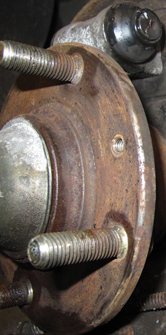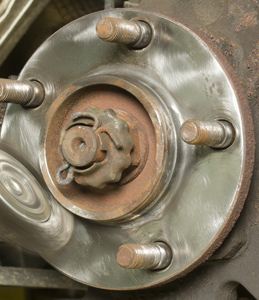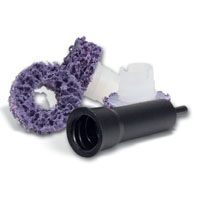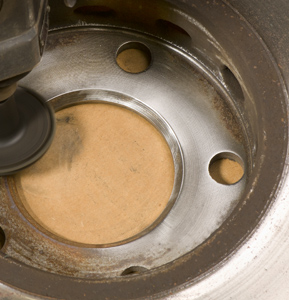Prevent brake rotor warp
How to prevent brake rotor warp
This is part of a two-part series on brake pedal pulsation that’s described by drivers as, “Car shakes when braking.” Read this article after you’ve read PART ONE
You can stop brake rotors from “warping” by following “best practices” when doing a brake job. If you skip the cleaning process, you’ll actually cause brake pedal pulsation commonly called brake rotor warping.
People will tell you the car shaking when braking (pulsation) is caused by warped rotors. They’re wrong. The rotors aren’t warped. Brake pedal pulsation is caused by disc thickness variation and that’s caused by later runout. Not cleaning the wheel hub and over-torquing the lug nuts is what causes lateral run-out. In plain English, the rotor is not sitting completely parallel with the hub.
Cleaning the wheel hub is critical
Most DIY home mechanics don’t pay any attention to the condition of the hub, but if you leave as little as .003” of rust on the hub face, it’s enough to cock the rotor “off parallel,” creating lateral run out.
As the rotor spins out of parallel, the high spot on one side of the rotor slaps the inboard pad and 180° later the high spot on the opposite side hits the outboard pad. Depending on the type of pad material you use, the pad will either deposit friction material onto the rotor, making it thicker in one area on each side, or the pad material will wear down the high spot in one area on each side of the rotor.
Improper lug nut torque causes lateral runout
The same lateral run-out and disc thickness variation can occur if you don’t use a torque wrench to tighten the lug nuts. Think of the wheel/rotor/hub like a sandwich. The rotor is sandwiched between the hub and the wheel by the clamping force of the lug nuts. If you don’t use a torque wrench, you’ll have uneven clamping force between lug nuts. A lug nut that’s over tightened will clamp the wheel and rotor closer to the hub. While a looser lug nut will provide less clamping power. In other words, if you don’t tighten the nuts evenly, one side of the rotor is tighter against the rusty hub than the other side. The only way to tighten evenly is with a torque wrench.
EXAMPLE:
Let’s say you didn’t clean the hub before installing the rotor and the rotor cocks .003” at the outside edge of the hub. Assume you’re driving on 205/55R16 tires. That means the rotor high spots slap the pads 836 times each mile. In 3,000 miles, the rotor has hit the pads 2.5 million times. Can you see how that many slaps could wear thin spots or deposit extra pad material to form thick spots?
The type of friction material you use determines whether the rotor’s high spot get thicker or thinner
Pads generate friction when pushed against the rotor. But there are two kinds of friction—abrasive and adherent. Abrasive friction is present in a pad where the friction material is harder than the rotor. So the rotor wears as well as the pad. This is the kind of wear action you’d find in a low metallic pad. If you have lateral run-out with this type of pad, they’ll wear a thin spot each time they slap the inboard and outboard pads. Now here’s where the pulsation comes in; As the thinner portion of the rotor reaches the pad area, the depression causes the caliper piston to move out of the bore. That causes a resulting drop in brake fluid pressure and pedal drop. Then, as the rotor continues to rotate, the thicker portion of the rotor comes into place, pushing the piston back into the bore. The increases fluid pressure and pushes the brake fluid backward, lifting the pedal. This is how disc thickness variation causes pedal pulsation. You’ll find low metallic pads on European, Asian, and some high-performance American cars
Adherent friction, on the other hand, is an action where the pads transfer a thin layer of friction material into the pores of the rotor, creating a film of friction material over the entire face of the rotor. Stopping action in this type of system is the result of film-on-film shear. As heat builds, the film on the rotor disintegrates, and new friction material re-deposits on the rotor face. To understand the adherent friction, think of winter snow tires. Winter tires achieve greater traction in fresh snow because the large voids between the tread blocks compress snow and push it against snow on the street. In this case, the increased traction is created by snow-on-snow contact (called snow shear). That type of traction is far greater than the traction that can be created by rubber on snow. Don’t believe it? Take two snowballs and slide them against each other. That’s snow-shear. Next, slide a chunk of dry rubber against the snow. The rubber produces far less friction.
The point here is that for adherent braking to work, it must deposit friction material onto the rotor. If the rotor isn’t parallel to the hub, the pads wipe too much friction material onto the high spots of the rotor, causing increased thickness. The result is increased fluid pressure and pedal pushback, followed by a return to normal rotor thickness and then piston outward movement, a drop in fluid pressure, and a lowered brake pedal.
In both cases, the end result is disc thickness variation CAUSED by lateral runout (rotor not parallel to the hub. Here’s an example:
Rotors don’t warp
Most people think rotors warp due to high heat—like an LP record left in the sun. They say it can happen after long braking periods, like going down the mountain. Overheating your brakes CAN cause disc thickness variation and car shaking when braking, but it’s not caused by a warped rotor. Instead, it’s caused by friction material deposits on the rotor face.
The people who insist that the rotor has warped simply don’t understand metallurgy. The amount of heat required to cast a rotor is 3-5 times higher than you could possibly create from even the most aggressive downhill braking. Based on the way rotors are designed and built, the metal will crack long before it can warp.
Rotor warp wouldn’t cause a car shakes when braking symptom
Still don’t believe me? Well, think about what would happen to a floating caliper IF the rotor was indeed warped. As the high wave spot approaches the inboard pad it’ll push against the caliper piston. If we assume the caliper slides are adequately lubed, the caliper body will respond by sliding away from the rotor. The caliper will pull the outboard pad along with it. There will be no increase or drop in pressure because the rotor THICKNESS is uniform. The floating caliper will slide back and forth on the slide pins, riding the “waves” of a warped rotor instead of causing pedal pulsation. If there’s no thickness variation, then there’s no brake pedal pulsation.
Of course, if the slides aren’t properly lubed, a caliper can’t float along with a wavy rotor. In that case, a ‘warped” rotor could cause the car to shake when you apply the brakes. And, if the lateral runout exceeds .010” the caliper can’t move (float) fast enough at high speeds, and “riding the waves” will create a pulsation. At low speeds, that kind of runout will feel like a surging movement, almost like the wheels are out of round. And, of course, a warped rotor would definitely cause pedal pulsation in a vehicle with fixed (not floating calipers).
The rotor manufacturers are telling us that in almost all cases where rotors are returned under warranty because they “warped,” the rotors actually have disc thickness variation (DTV).
It’s the DTV, stupid. Now let’s prevent it.
The best way to eliminate car shaking when braking caused by disc thickness variation is to clean the hub and make sure it doesn’t have more than .006 lateral run out. Your job is to clean the rust off the hub
without removing metal. 3M makes some hub cleaning products. Or you can use a drill and wire wheel, sandpaper, or scrub pad. Once you’ve cleaned the hub, apply a very thin film of synthetic high-temperature brake grease to reduce future rust buildup. Do NOT use the anti-seize compounds. And clean the inside of the rotor “hat” area if you plan to re-use the old rotor.
Apply the same high-temperature grease to the pad slide areas to prevent end-tab rust on the pad backing plate. And apply high temp grease to the caliper slide pins. If you find any corrosion on the slide pins, replace them. They run about $10 for a set of two.
Always use a torque wrench to tighten lug nuts
Proper lug nut torque is CRITICAL to maintaining true rotors. In a recent GM seminar, an engineer disclosed that if you under-torque a single lug nut, you can cause up to .003” of lateral runout.That means you MUST use a torque wrench. I’m not a big fan of those cheapies you can buy at Harbor Freight. But, if you buy one of those, at least you have a chance that each of the lug nuts is tightened to the same torque (or close to it). The correct way is to tighten the lug nuts to 50% of the spec, and in a criss-cross pattern. Then return and tighten to the full spec.
So here’s the best way to prevent lateral runout and disc thickness variation
1) Clean the hub with the 3M products above or a wire brush. Then clean the rust off the backside of the wheel.
2) To prevent rust from forming again, apply a thin coat of nickel anti-seize (not aluminum) or high-temperature brake grease on the face of the hub. Do not EVER lubricate the studs!!! This is EXTREMELY important. If the lug nut is hard to install on the stud, get a new lug nut or replace the stud—it means the threads are distorted. Do NOT coat the studs with anti-seize.
3) Install the wheel and torque the lug nuts in a star-shaped pattern to one-half the specified torque. This is known as pre-stretch. Then reset your torque wrench to the specified torque and tighten them all to full torque. It’s a two-step process.
I know. I know—nobody does it that way. Then again, everybody complains about warped rotors, too.
© 2012 Rick Muscoplat
Posted on by Rick Muscoplat




